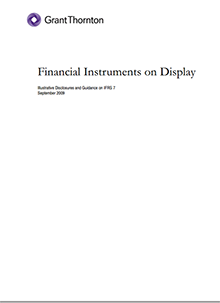-
Audit
At Grant Thornton, our IFRS advisers can help you navigate the complexity of financial reporting.
-
IFRS support
Our IFRS advisers can help you navigate the complexity of the Standards so you can focus your time and effort on running your business.

-
Transfer pricing
The laws surrounding transfer pricing are becoming ever more complex, as tax affairs of multinational companies are facing scrutiny from media, regulators and the public
-
Tax Audit
Our trusted teams can prepare corporate tax files and ruling requests, support you with deferrals, accounting procedures and legitimate tax benefits.
-
Tax Appeal
Our teams have in-depth knowledge of the relationship between domestic and international tax laws.
-
Advance Ruling
Through our global organisation of member firms, we support both companies and individuals, providing insightful solutions to minimise the tax burden for both parties.
-
Tax Treaty Benefits Application
Tax Treaty Benefits Application
-
FINI/FIDI Tax Services
Our solutions include dealing with emigration and tax mitigation on the income and capital growth of overseas assets.
-
Expatriate Income Tax Filing
Our team has extensive experience in helping expatriates in Taiwan to file personal income returns and claim tax refund where applicable. We file approximately 300 expatriate personal income tax returns in Taiwan annually.
-
Bookkeeping
Effective bookkeeping and financial accounting are essential to the success of forward-thinking organisations. To get the optimum benefit from this part of your business, you'll need an experienced team behind you.
-
Inventory movement reporting
Outsourcing your operations and specific business functions to Grant Thornton can not only cut costs, but also bring new insights and experience to your business.
-
Payroll administration
Payroll and, in addition, personnel administration are the biggest and most time-consuming challenges facing expanding organisations. Grant Thornton’s outsourcing teams can manage these commitments on your behalf, allowing you to focus on what you do best – growing your business.
-
Trust account management
Running a transparent and trusted business means keeping shareholders, owners, management and other important stakeholders informed about key developments in your organisation.
-
VAT returns
VAT returns
-
Head Office reporting
Head Office reporting
-
Work Permit Application Services
Work Permit Application Services
-
Expatriate Tax
Expatriate Tax
-
PRIMA Consulting Services
PRIMA Consulting Services
-
Business Operation Plan Composition
Business Operation Plan Composition
-
Setting up legal entities
With a global network of experts in their respective tax and regulatory environments, Grant Thornton advisors help individuals and corporations establish the type of business entity that will best position them to achieve their goals from the very start of their operations.
-
Liquidation and de-registration
Sometimes a business suffers an adverse event which impacts its ability to continue trading. And sometimes a solvent sale proves unsuccessful or a turnaround just isn't an option.
-
Update company statutory record
With a global network of experts in their respective tax and regulatory environments, Grant Thornton advisors help individuals and corporations establish the type of business entity that will best position them to achieve their goals from the very start of their operations.
-
Merger and Acquisition
Merger and Acquisition

-
Administrative remedies
Administrative remedies
-
Corporate legal consulting
Corporate legal consulting
-
Bankruptcy and restructuring
Bankruptcy and restructuring
-
Company dissolutions and liquidations
Company dissolutions and liquidations
-
Supplier and employee background investigations
Supplier and employee background investigations
-
Legal attest letter drafting service
Legal attest letter drafting service
-
Preparation and review of agreements in Chinese and English
Preparation and review of agreements in Chinese and English
-
Lifting restrictions on going abroad
Lifting restrictions on going abroad
-
Labor law compliance and labor-management negotiation
Labor law compliance and labor-management negotiation
-
Business and personal asset planning
Inheritance, inheritance tax, family business, and personal asset planning
-
Not for profit organizations
Not for profit organizations
-
Schools
Schools
-
Others
Others
IFRS 7 Financial Instruments: Disclosures (IFRS 7) is not new - it came into effect for annual periods beginning on or after 1 January 2007. Nonetheless we think this guide is very topical. Experience has shown that IFRS 7 presents challenges, and two years of practical experience enables us to share our insights into the most problematic areas. Moreover, the global financial crisis has put the spotlight on the adequacy of risk and other disclosures concerning financial instruments. The crisis has also led the IASB to add some significant new requirements to IFRS 7 in recent months. The latest edition of the publication has been updated to reflect these requirements which come into effect from 1 January 2009.
Achieving compliance with IFRS 7 takes time and should not be under-estimated. The instruments covered are extensive, ranging from straightforward financial assets and liabilities such as bank accounts, trade receivables and trade payables to more complex financial instruments such as derivatives. Also, IFRS 7 sets out principles for disclosure - it includes some detailed guidance but application requires significant management judgement. It is for management to decide on the precise form and content of disclosure in order to best meet the objectives. Indeed, experience to date shows that disclosures vary considerably between entities.
The member firms of Grant Thornton International have gained extensive insights into the principles for disclosures of financial instruments. We are pleased to share these insights by publishing this guide which reflects the collective experience of Grant Thornton International's IFRS team and member firm IFRS experts.
For further information on the guide or the issues raised in it, please contact us.




